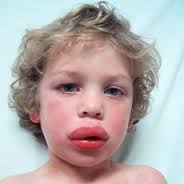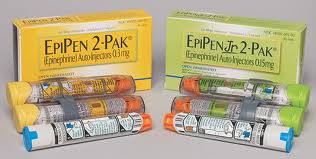Monitor the Casualty's Condition and Respond in Accordance with First Aid Principles
Anaphylaxis
 Anaphylaxis is the most severe form of an allergic reaction and has the potential to be life-threatening. Anaphylaxis occurs after exposure to an allergen such as food (e.g. nuts), herbal remedies, latex, insect stings (e.g. bees) or medicine to which a person is already extremely sensitive.
Anaphylaxis is the most severe form of an allergic reaction and has the potential to be life-threatening. Anaphylaxis occurs after exposure to an allergen such as food (e.g. nuts), herbal remedies, latex, insect stings (e.g. bees) or medicine to which a person is already extremely sensitive.
It takes only 1 to 2 minutes for a mild allergic reaction to escalate to anaphylaxis. Some casualties may find symptoms they experience are always mild. For example, there may be a tingling or itching in the mouth and nothing more.
Anaphylaxis is a preventable and treatable event. The most important aspect of the management of casualties with life-threatening allergic reaction is avoidance of any known triggers such as:
- Food. Most commonly nuts, sesame seeds, shellfish, cow milk, soy, egg and wheat
- Herbal remedies. Such as Royal Jelly.
- Insect stings. Such as bees and wasps. The venom from these insects is different in each case and therefore allergy to one does not increase the risk of reactions to another.
- Latex allergy. Rare, but more common in some people frequently exposed to latex such as health care workers.
- Medication. Particularly antibiotics and sometimes x-ray contrast dyes.
Casualties who have a history of anaphylaxis are often prescribed self-administered adrenaline using an EpiPen(r) or EpiPen(r) Jr.
If this is the case assist the casualty to self-administer their EpiPen(r) adrenaline. Another less common brand of self-administered adrenaline is AnaPen(r) or AnaPen(r) Jr
Signs and symptoms
Most noticeable signs and symptoms:
- Hives
- Swelling of the throat, lips, tongue or around the eyes
- Difficulty speaking, breathing or swallowing

Common signs and symptoms may include:
- Metallic taste in the mouth
- Generalised warmth, flushing, itching or redness of the skin
- Chest discomfort
- Increased heart rate
- Abdominal cramps, nausea, vomiting or diarrhoea
- Sudden feeling of dizziness or weakness
- Anxiety or a sense of doom
- Collapse
- Loss of consciousness
Care and treatment
- Lay person flat, do not stand or walk. If breathing is difficult allow to sit
- If available assist with EpiPen(r) or AnaPen(r)
- Call triple zero (000) for an ambulance
- Contact family/emergency contact
- Further adrenaline doses may be given if no response after 5 minutes
EpiPen(r)
- Remove the epipen(r) or epipen(r) Jr from the packaging
- Grasp the unit, with the black tip pointing downward
- Form a fist around the epipen(r) or epipen(r) Jr with black tip down
- Pull off the gray cap
- Place black end against outer mid-thigh (with or without clothing)
- Push down hard until a click is heard or felt
- Hold in place for 10 seconds
- Remove epipen(r) or epipen(r) Jr and massage the injection area for 10 seconds
- Check black tip
- If needle is exposed the dose has been administered
- If not, hold black tip near outer thigh and repeat administration
- Bend the needle back against a hard surface
- Carefully put the unit (needle first) back into the carrying tube (without the gray activation cap)
- Recap the carrying tube
- Observe for relapse as severe symptoms sometimes recur after apparent recovery
- Further epipen(r) or epipen(r) doses may be given if no response after 5 minutes
New Look EpiPen(r)
- Remove the EpiPen(r) or EpiPen(r) Jr from the packaging
- Form fist around EpiPen(r) and pull off blue safety release
- Place orange end against outer mid-thigh (with or without clothing)
- Push down hard until a click is heard or felt and hold in place for 10 seconds
- Remove EpiPen(r) and massage injection site for 10 seconds

AnaPen(r)
- Remove the anapen(r) or anapen(r) Jr from the packaging
- Pull off black needle shield
- Pull off grey safety cap from red button
- Place needle end firmly against outer mid-thigh at 90° angle (with or without clothing)
- Press red button so it clicks and hold for 10 seconds
Never put thumb, fingers or hand over black tip. Do not remove gray activation cap until ready to use.
EpiPen(r) Jr is generally prescribed for children aged 1-5 years. AnaPen(r)Jr. is generally prescribed for children weighing 10 - 20 kg Medical observation in hospital for at least 4 hours is recommended after anaphylaxis.
Asthma
Australia has one of the highest rates of asthma in the world. Over 400 Australians die from asthma each year and many of these deaths may be preventable. Asthma sufferers have very sensitive airways and when they are exposed to certain triggers, their airways narrow making it difficult for them to breathe. An asthma attack can take anything from a few minutes to a few days to develop. There are three main factors that cause airways to become narrow:
- The inside lining of the airways becomes red and swollen (inflamed)
- The muscle around the airways constrict (tighten)
- Extra mucus may be produced
Trigger factors for asthma may include
- Colds and flu
- Exposure to known allergens, e.g. dust mite, pollens, animal dander, moulds
- Exposure to chemicals or other occupational sensitisers
- Exposure to irritants e.g. cigarette smoke, perfume
- Reflux
- Drugs e.g. aspirin and beta-blockers
- Foods e.g. nuts, seafood
- Food additives, colourings, monosodium glutamate (MSG)
- Changes in weather, exposure to cool air
- Exercise
- Emotion
Asthma is usually considered in three classifications of severity, mild, moderate and severe.
Signs and symptoms
- Pale, cool, clammy skin
- Coughing, especially at night
- Shortness of breath - using all the chest and diaphragm muscles to breathe
- 'Sucking in' of the throat and rib muscles
- Severe chest tightness
- Wheezing - a high pitched raspy sound
- Cyanosis around the lips (bluish colour)
- Anxiety and distress
- Exhaustion
- Rapid, weak pulse
- Little or no improvement after using reliever medication (Airomir, Asmol, Bricanyl, Epaq or Ventolin)
- Severe asthma attack: collapse - leading to eventual respiratory arrest